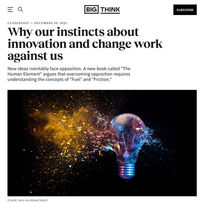
David Schonthal is an award-winning Professor of Strategy, Innovation & Entrepreneurship at the Kellogg School of Management and a bestselling author of the book, The Human Element: Overcoming the Resistance That Awaits New Ideas (Wiley). David has been a practitioner of entrepreneurship, design, and innovation for over 20 years and his work has led to creation of over 300 products, services and new ventures around the world.
DAVID
SCHONTHAL
What invisible forces slow or stall even our best innovation efforts? Schonthal and Nordgren identify four "Frictions" that get in the way, and then tell us how to overcome them. The Human Element is full of insights for designers, innovators, and executives alike.
"
Perfect for business leaders, product managers, educators, and anyone else who seeks to bring new and exciting ideas to life, The Human Element is an indispensable resource to help people overcome the powerful forces of human nature that instinctively resist change.
An engrossing read on what it takes to open other people's minds.
ADAM GRANT
"
3-TIME, BEST-SELLING AUTHOR OF THE TEN FACES OF INNOVATION, THE ART OF INNOVATION AND CREATIVE CONFIDENCE
THE HUMAN ELEMENT
BOOK
TOM KELLEY

"
Whether you're a creator looking to execute or an executive looking to create, this book is a timely read.
DANIEL PINK
AUTHOR OF WHEN, DRIVE,
& TO SELL IS HUMAN
WHAT IS FRICTION THEORY?
How do you get people to say yes to a new idea or innovation? The deep assumption of most marketers, innovators, executives, activists, or anyone else in the business of creating change, is that the way to sell an idea is to focus on heightening its appeal. We instinctively believe that if we add enough value, people will say “yes”. This reflex tends to lead us down a path of adding features to an idea and amplifying its benefits in order to get others on board. These activities and strategies designed to generate demand is a set of tactics we refer to in the book collectively as “Fuel”.
But by focusing on Fuel to enhance attraction, innovators often neglect the other half of the equation – the Frictions that work against the desired behavior we seek in others. Frictions are the psychological forces that oppose and undermine change. Though rarely considered, identifying, understanding and overcoming these Frictions is often the key to successfully achieving our innovation goals.














